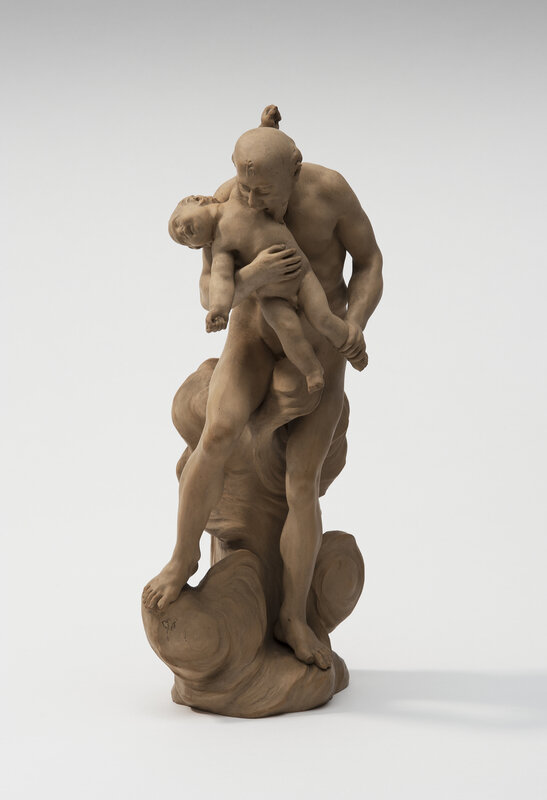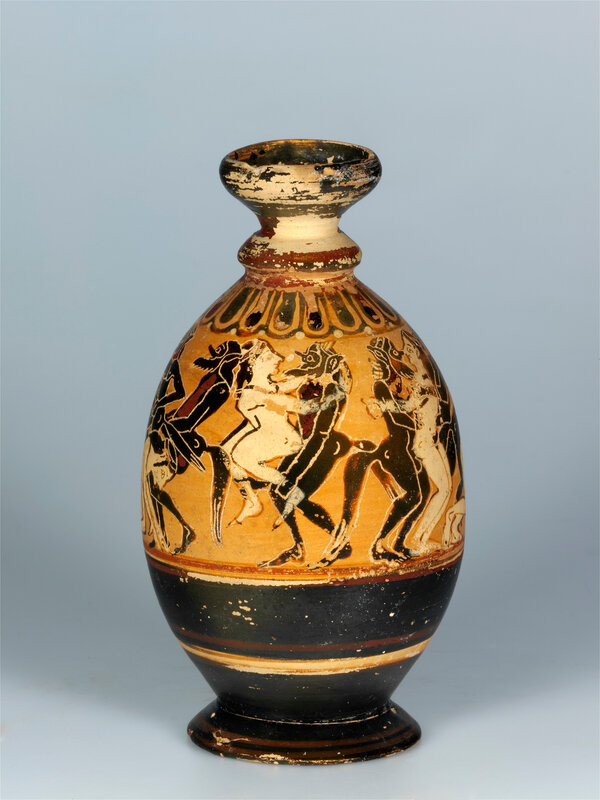Exhibition at Altes Museum explores the relationship between men and meat
Jean-Antoine Houdon, Muscle man , late 18th cent. Bronze, gilded © National Museums in Berlin, Sculpture Collection and Museum of Byzantine Art / Antje Voigt
BERLIN.- When we think of flesh and meat, the first thing that comes to mind is usually food. But also our own bodies consist of meat. For thousands of years, meat has played a central role in cultural and ritual contexts as well. In short: meat is food, body, and cult. The transition from the realm of the living to the realm of the dead becomes apparent within it. In the exhibition, the relationship between men and meat as well as meat’s complex cultural connotations are presented while exploring the tensions surrounding the becoming and decay of flesh. The exhibition is interdisciplinary and spans the collections of the Staatliche Museen zu Berlin, including archaeological, ethnological, and art-historical objects from 5,000 years of human history. The works range from a clay tablet containing 58 different porcine terms from the late Uruk period (approx. 3300–3000 BC) to the works of contemporary artists such as Vanessa Beecroft, Christian Jankowski, and Bruce Nauman.
Christoph Weiditz, Fortuna or Venus, around 1550. Bronze, fire-gilded © Staatliche Museen zu Berlin, Sculpture Collection and Museum of Byzantine Art / Jörg P. Anders.
Meat is Food
Historical representations of the hunt are opposed to Christian Jankowski’s video Die Jagd (The Hunt, 1992–1997). At a time when the provisioning of meat is no longer essential to survival, Jankowski’s chivvy at the local supermarket strikes us as absurd, yet it also puts on display the alienation which goes hand in hand with the modern food industry. The pig, which is the only animal to be bred and kept exclusively to be used for its meat, represents the relationship between human and animal. In the late Uruk period (approx. 3300–3000 BC), 58 different terms for the word ‘pig’ were specified. The picture story by Ludwig Emil Grimm showing the life, death, and afterlife of a sow depicts an emotionally charged individual fate of a pig, while the clinical descriptions in the handbook for sanitary and administrative workers at a US-American industrial slaughter-house around 1900 offer a more sober and objective view on the animal.
Vanessa Beecroft, VB 55.004, Performance in the Neue Nationalgalerie, 8.4.2005. Digitalprint © Staatliche Museen zu Berlin, Nationalgalerie / Stefanie Dietzel
Meat is Cult
Meat plays a role in almost all religions, especially in dietary rules. Godly forces, which lie beyond the mortal flesh, were and are still worshipped in many cultures. Cultic rituals ranging from animal to human sacrifice often take a central place within individual religious societies. Within the exhibition this dimension of meat is explored through the Christian narrative of the body of Christ on one hand and through religious offerings of flesh from antiquity to the present day on the other. The ethnological field research video Durgapuja: Gonzo Goes Ritual from 2003, which shows a ritual goat slaughter, is thus placed alongside a splendorous monstrance from 1629.
Kronos / Saturn, devouring his child. Design: Wenzel Neu. Execution: Porzellanmanufaktur Kloster Veilsdorf, clay fired around 1766 © Staatliche Museen zu Berlin, Kunstgewerbemuseum / Saturia Linke
Meat is Body
The body as a mobile and nevertheless transitory foundation for life has always been closely interwoven with cultural and political struggles. In this context, the exhibition explores such avenues as the decay of flesh and laceration through combat, considers body images and bodily experiences, and shows the connection between fertility symbols and Lustmord. Meat as body thus moves between mortality, sexuality, and body modification. With his work Body Pressure (1974), Bruce Nauman uses a performance to invite visitors to feel their own body and become more conscious of it.
Hans Schwarz, Death and the Girl, c. 1520 . Boxwood © Staatliche Museen zu Berlin, Sculpture Collection and Museum of Byzantine Art / Antje Voigt
After the success of the exhibition Bart (Beards) in 2015/16 at Neues Museum, Fleisch (Flesh / Meat) is the second exhibition realized by young curators of the Staatliche Museen zu Berlin, spanning twelve of the museums’ collections.
Francis Bacon, Logique de la sensation, 1981. Color lithograph © Staatliche Museen zu Berlin, Kupferstichkabinett / Jörg P. Anders
Official figure with pig head, China, 19th century, porcelain © National Museums in Berlin, Ethnological Museum / Martin Franken
Hedwig Bollhagen, Piggy bank, around 1996, Brandenburg, faience, glazed, painted © Staatliche Museen zu Berlin, Museum Europäischer Kulturen / Christian Krug
Vessel in the shape of a pig, Egypt, Mergelton © National Museums in Berlin, Egyptian Museum and Papyrus Collection / Sandra Steiß
Painted piggy, Troy, clay, painted, 1800-1100 BC Chr. © Staatliche Museen zu Berlin, Museum of Prehistory and Early History / Jürgen Liepke
Reichsfleischkarte Kingdom of Saxony, 1917. Paper © Staatliche Museen zu Berlin, Museum Europäischer Kulturen
Alexander Enger, On the Fleischhof Lüneburger Straße in Moabit, around 1964. Photography © Staatliche Museen zu Berlin, Art Library / Alexander Enger
Corinthian Lekythos, c. 560 BC Chr. Clay, painted blackfigure © National Museums in Berlin, Collection of Classical Antiquities
Phallus follower, Roman, dating unknown. Bronze © Staatliche Museen zu Berlin, Antikensammlung / Johannes Laurentius

/https%3A%2F%2Fprofilepics.canalblog.com%2Fprofilepics%2F1%2F0%2F100183.jpg)
/https%3A%2F%2Fstorage.canalblog.com%2F03%2F02%2F119589%2F96711876_o.jpg)
/https%3A%2F%2Fstorage.canalblog.com%2F11%2F31%2F119589%2F94773502_o.jpg)
/https%3A%2F%2Fstorage.canalblog.com%2F20%2F83%2F119589%2F94772815_o.jpg)
/https%3A%2F%2Fstorage.canalblog.com%2F26%2F72%2F119589%2F75604929_o.jpg)
/https%3A%2F%2Fstorage.canalblog.com%2F59%2F60%2F119589%2F26458628_o.jpg)
















/image%2F1371349%2F20240227%2Fob_0fb80f_vcsprasset-3568579-188440-33388f9b-068.jpg)
/http%3A%2F%2Fstorage.canalblog.com%2F95%2F36%2F119589%2F127146553_o.jpg)
/http%3A%2F%2Fstorage.canalblog.com%2F69%2F23%2F119589%2F126179674_o.jpg)
/http%3A%2F%2Fstorage.canalblog.com%2F12%2F77%2F119589%2F126054306_o.jpg)